ST PAUL, Minn. — Friday, Feb. 5
- State on the cusp of 500,000 vaccinated
- Minnesota has 18 cases of two new COVID variants
- Health officials warn against travel, Super Bowl parties
- Winter high school state tournaments scheduled
- Minnesota to receive 83K+ vaccine doses next week
The number of state residents who have received COVID-19 vaccine is nearing a milestone, according to data released Friday by the Minnesota Department of Health (MDH).
MDH's vaccine dashboard says 497,843 people have received at least one dose of the vaccine as of Wednesday, making it almost certain the state will reach the half-million mark on Saturday. Health officials say 138,212 Minnesotans have completed the two-shot series.
Overall, 9% of state residents have received at least one dose of vaccine.

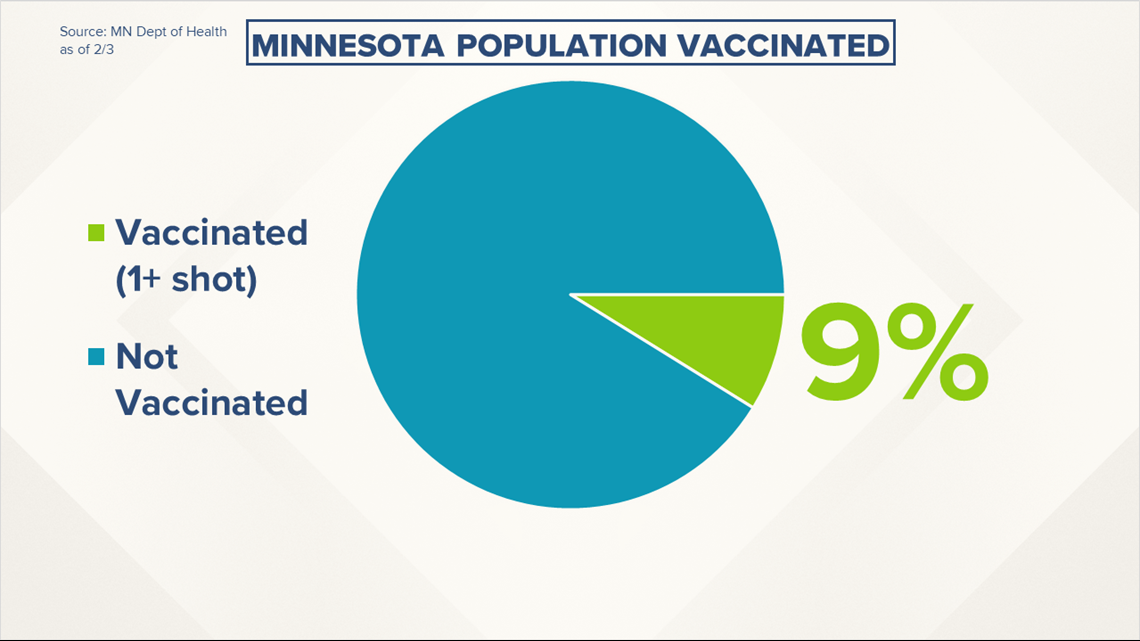
Providers continue to make slow progress on the goal of a directive from Gov. Tim Walz that 90% of all vaccine received be administered to patients within three days. As of Wednesday that number was at 83%. Providers are currently using 95% of vaccines received within seven days.
New cases of coronavirus dipped a bit with health officials recording 1,054 in the past day, based on 38,947 tests (35,660 PCR, 3,278) processed in private and state labs. Single-day cases down from 1,410 reported Thursday, but testing volume dipped slightly as well.
Minnesota has had 466,224 positive cases since the start of the pandemic, 20,745 of them associated with an antigen test.

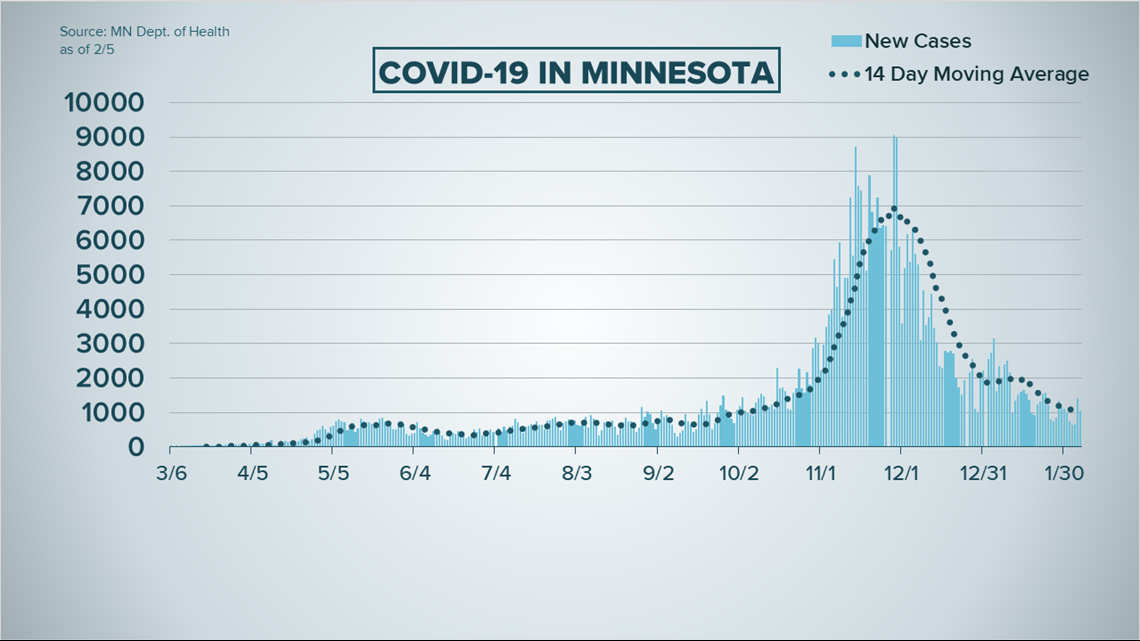
An additional 22 deaths from the virus were recorded, bringing total fatalities to 6,273. Of those deaths 3,960, or 63% of them are associated with assisted living or long-term care settings.
The number of hospital beds across Minnesota being used to treat COVID patients has flattened out. As of Thursday 362 beds were filled with coronavirus patients, 83 of them ICU beds. In the Twin Cities metro availability remains tight, with just 3.6% of non-ICU beds (132) open for new patients across the system.
Total hospitalizations from the pandemic are now up to 24,617, with 5,092 of those patients requiring ICU care. MDH says 450,924 people who at one time tested positive for the virus have recovered to the point they no longer need to be isolated.


Young adults from 20 to 24 account for the largest group of Minnesota's COVID cases with 46,815 and three deaths, followed by people 25 to 29 with 41,904 cases and six deaths, and those 30 to 34 with 39,038 cases and 11 fatalities.
The largest grouping of deaths involves people 85 to 89, with 1,194 fatalities in 6,097 cases.
Hennepin is the state's most active COVID county with 96,785 cases and 1,546 deaths, followed by Ramsey County with 41,578 and 776 deaths, Dakota County with 34,515 cases and 370 deaths, and Anoka County with 32,076 cases and 374 deaths.
Cook County in northeastern Minnesota has registered zero deaths from COVID, and just 116 cases since the pandemic arrived in the state. Lake of the Woods County has the second-lowest number of cases with 207, and one fatality.
Thursday, Feb. 4
2 p.m.
State health officials say even though people may be hearing about "hopeful downturns" in case numbers, it's important to keep in mind that Minnesota has still regularly been seeing more than 1,000 cases per day.
Minnesota Department of Health (MDH) Commissioner Jan Malcolm gave an update on COVID spread during a regular briefing call Thursday afternoon.
"We do see some apparent leveling off," Malcolm said, "and our situation in Minnesota has been looking better in recent weeks."
Minnesota's seven-day average rolling test positivity rate is at 4.3%, and Malcolm said health officials are always happy to see it below 5%.
State Epidemiologist Ruth Lynfield said officials remain concerned about new, more contagious variants of the virus causing spikes in cases even as they race to get the population vaccinated.
Lynfield said 541 cases of the B117 variant, first identified in the UK, have been identified in the U.S. Only three cases of the South Africa variant, B1351, have been reported in the country, and only in two states.
Sixteen cases of the B117 variant have been detected in Minnesota. Twelve had traveled or had household members who traveled. Four of the travelers were international travelers, three to West Africa and one to the Dominican Republic. Seven other cases were associated with domestic travel, including three to California.
The only two cases of the Brazilian P1 variant in the U.S. have been in Minnesota. Both were from the same household and both had traveled, Lynfield said.
"It is not a surprise that we detected another case, but it underscores the need for continued vigilance," she said.
MDH is doing "random surveillance" by asking other labs to send some samples in to be tested for the new variants. Lynfield said through that process they have identified four people who contracted the new variants and did not travel.
"Therefore, they contracted it in the community," she said.
Malcolm said that more than 475,000 Minnesotans have now received at least one dose of a COVID vaccine, and nearly 130,000 have both doses.
Minnesota is expecting 83,825 doses of vaccine next week, according to MDH Infectious Disease Director Kris Ehresmann. That includes the 16% increase the Biden administration has previously talked about, Ehresmann said, as well as an additional 5% increase for this specific week.
Of those, Ehresmann gave a distribution breakdown:
- 3,000 for tribal nations
- 7,000 for the state 65+ sites
- 10,000 for education and child care workers
- 39,800 for health care providers
- 14,825 for local public health to finish Phase 1a
- 4,200 for pharmacies, including 3,000 for long-term care
- 5,000 for the Department of Human Services' outreach to group homes
Ehresmann said those are all first doses. Second doses are automatically going to the places that already distributed first doses, at the appropriate time intervals.
Regarding the possibility that some second doses could be delayed in order to speed up the distribution of first doses, Ehresmann said that decision would need to be made at the federal level.
Ehresmann also pointed out that Minnesota has not finished vaccinating all health care workers, because MDH expanded the eligible groups according to federal guidance before they had completed Phase 1a.
"There still are health care workers who still need to be vaccinated and have not had that opportunity," Ehresmann said.
Ehresmann said the department is aware that many people are wondering if they can travel. She recommended visiting the CDC's website for current recommendations.
"The most important thing to know is that COVID is still spreading in communities all over the United States," Ehresmann said. She warned that traveling increases your chance of getting and spreading the coronavirus.
Ehresmann said the CDC is recommending that people don't travel at all right now. It's especially important to avoid travel if you're sick, Ehresmann said, or if you've tested positive for COVID-19.
"If you absolutely need to travel, there are are some things to keep in mind," Ehresmann said.
She said travelers should wear a mask, stay six feet apart, avoid crowds and wash your hands often. People should also get tested before and after traveling, and quarantine after travel even if they test negative. Anyone who is eligible should get vaccinated fully before they travel.
There are different restrictions on travel for many local, state and national governments, so travelers are urged to check those restrictions before they go.
MDH also warned that people should avoid having gatherings around the Super Bowl this Sunday.
"This is probably the year to not be having a big Super Bowl party," Ehresmann said.
Lynfield also reminded the public that any time they have contact with someone who's not in their household, they should wear a mask and practice social distance.
"Because people are not detecting where they're getting it," she warned.
11 a.m.
New COVID-19 cases more than doubled Thursday according to new data released by the Minnesota Department of Health (MDH), but those numbers are accompanied by a huge increase in testing volume.
State health officials recorded 1,410 new coronavirus cases in the past day, after reporting just 669 in Wednesday. Those cases are based on the results of 50,330 tests (44,324 PCR, 6,006 antigen) processed in private and state labs. That testing volume is well over two times the number of tests reported Wednesday, which at least partially explains the significant jump in new cases.
Health experts consider a positive PCR test a confirmed COVID case, while a positive antigen test is considered a probable case. Minnesota has now recorded 465,176 total cases of the virus, 20,610 of them associated with antigen tests.
Another 17 Minnesotans have died from the virus, bringing total fatalities in the state to 6,251 since the pandemic began. Of that number 3,995, or 64% of them, are tied to long-term care or assisted living settings.

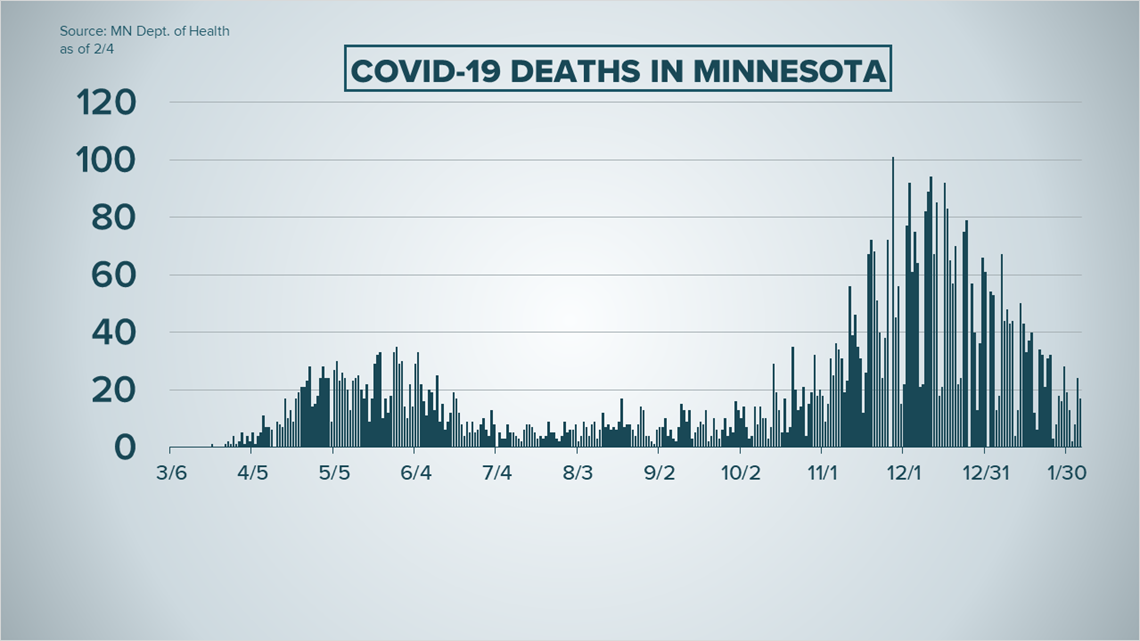
Total hospitalizations from COVID-19 now sit at 24,565, with 5,079 of those requiring ICU care. MDH says 450,383 people who at one time tested positive have recovered enough that they no longer need to be isolated.
The effort to vaccinate is moving ahead steadily, with 475,200 Minnesotans having received at least one dose as of Tuesday. MDH says 128,694 people have completed the two-shot series, and those numbers should rise more rapidly with the opening of two larger community clinics in Minneapolis and Duluth.

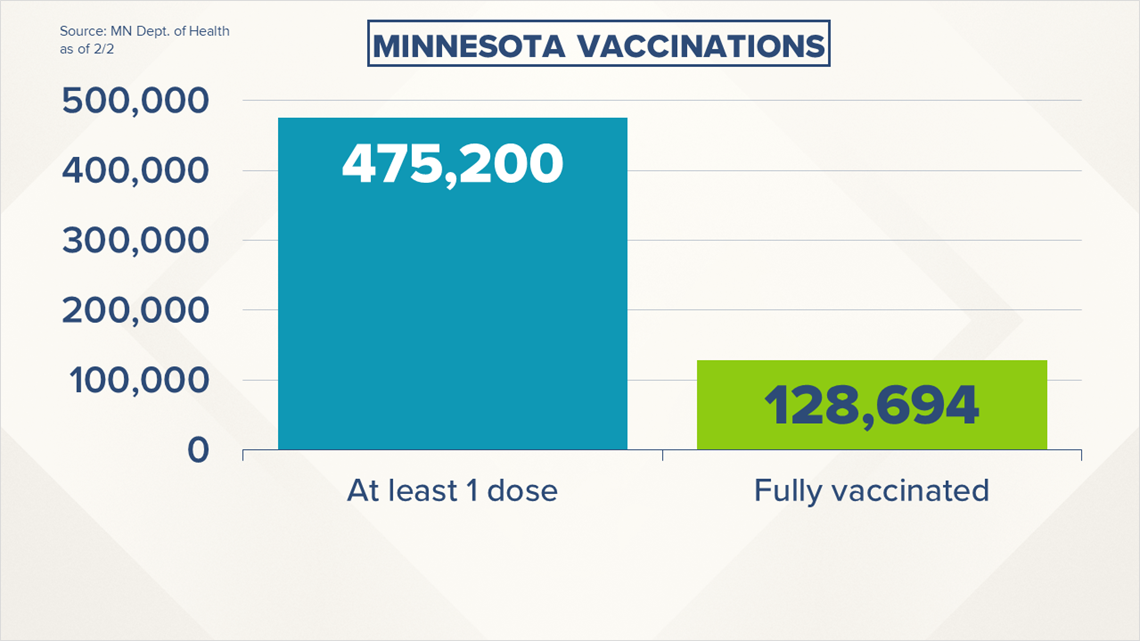
At this point vaccine providers are still short of Governor Walz's directive to administer 90% of the vaccines they receive within three days time. Currently that number stands at 82%.
People ages 20 to 24 make up the largest group of cases in the state with 46,720. Three people from that demographic have died. Those ages 25 to 29 are the next largest group with 41,795 and six deaths.
State data says the largest grouping of deaths involves people ages 85 to 89, with 1,192 fatalities in just 6,086 diagnosed cases.
Hennepin County has recorded the most COVID cases in the state with 96,570 and 1,541 deaths, followed by Ramsey County with 41,485 cases and 773 deaths, Dakota County with 34,435 cases and 369 deaths, and Anoka County with 32,006 cases and 375 deaths.
Cook County has the least COVID activity in Minnesota, holding steady at 116 cases since the pandemic started. Lake of the Woods County has the next lowest case number with 207.

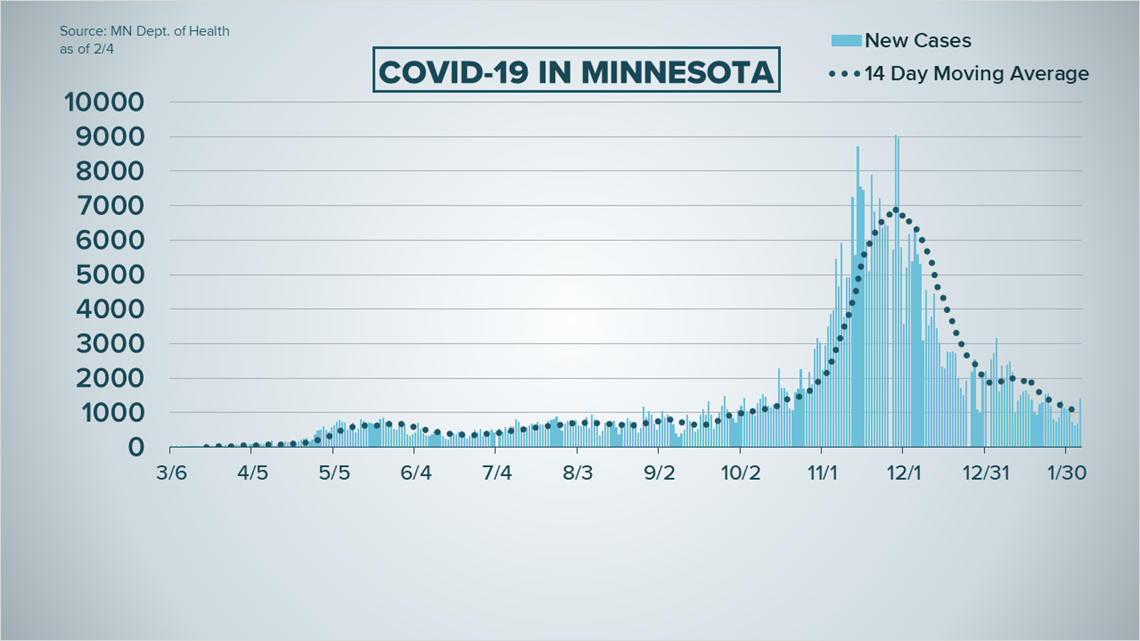
KARE 11’s coverage of the coronavirus is rooted in Facts, not Fear. Visit kare11.com/coronavirus for comprehensive coverage, and kare11.com/vaccine for answers to all of your questions about the race to get the U.S. vaccinated. Have a question? Text it to us at 763-797-7215. And get the latest coronavirus updates sent right to your inbox every morning. Subscribe to the KARE 11 Sunrise newsletter here. Help local families in need: www.kare11.com/give11.
The state of Minnesota has set up a data portal online at mn.gov/covid19.

